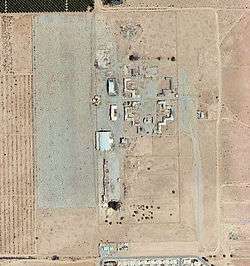W. R. Byron Airport
| W. R. Byron Airport (formerly Gary Field) | |||||||||||
|---|---|---|---|---|---|---|---|---|---|---|---|
|
USGS 2006 orthophoto | |||||||||||
| IATA: none – ICAO: none – FAA LID: 44CA | |||||||||||
| Summary | |||||||||||
| Airport type | Private use | ||||||||||
| Owner | Willard R. Byron | ||||||||||
| Serves | Blythe, California | ||||||||||
| Elevation AMSL | 400 ft / 122 m | ||||||||||
| Coordinates | 33°40′45″N 114°38′37″W / 33.67917°N 114.64361°WCoordinates: 33°40′45″N 114°38′37″W / 33.67917°N 114.64361°W | ||||||||||
| Map | |||||||||||
 44CA Location of airport in California | |||||||||||
| Runways | |||||||||||
| |||||||||||
W. R. Byron Airport (FAA LID: 44CA) is a privately owned, private use airport in Riverside County, California, United States. It is located four nautical miles (5 mi, 7 km) northwest of the central business district of Blythe, California,[1] within the city limits.
Facilities
W. R. Byron Airport has one runway designated 18/36 with an asphalt surface measuring 2,640 by 660 feet (805 x 201 m).[1]
History
The airfield opened on June 29, 1942. Known as Blythe Field and Gary Field, it began training United States Army Air Forces flying cadets under contract to Morton Air Academy. Assigned to United States Army Air Forces West Coast Training Center (later Western Flying Training Command) as a primary (level 1) pilot training airfield. It had three 2,100' active hard-surfaced runways and three local axillary airfields for emergency and overflow landings. Flying training was performed with Fairchild PT-19s as the primary trainer; it also had several PT-17 Stearmans assigned. Known sub-bases and auxiliaries assigned to the field were:
- Ripley Auxiliary Field #1 (33°32′28″N 114°39′08″W / 33.54111°N 114.65222°W)
- Ripley Auxiliary Field #2 (33°34′38″N 114°37′59″W / 33.57722°N 114.63306°W)
It was inactivated on August 4, 1944 with the drawdown of AAFTC's pilot training program, then declared surplus and turned over to the Army Corps of Engineers on September 30, 1945. Eventually discharged to the War Assets Administration (WAA), and the facilities of the former airport were reused by Palo Verde Community College. The college opened at the site on September 15, 1947 and it was at this point that any aviation use of the airfield presumably ended.
Palo Verde College opened its doors as a junior college, having an initial enrollment of seventeen students. By 1950, enrollment had reached 250. In September 1958, the College moved to East Hobsonway, and closed its facilities at the former airport.
The site of Gary Field was reused as a private airfield beginning in 1981 as W. R. Byron Airport and is a privately owned airfield.
Today, many of the original hangars & buildings remain standing. In particular, the characteristic irregular arrangement of the barracks buildings which remains at the site make the location of Gary Field very much recognizable. One of the large arch-roof hangars remains standing (at the southwest corner of the group of buildings), as well as the tower/operations building (just north of the large hangar), as well as one smaller hangar (northeast of the tower/operations building). The second large hangar (at the northwest corner of the site) was apparently removed, but its foundation is still clearly recognizable.
An interesting sidebar to history puts billionaire Kirk Kerkorian at Morton Air Academy as a flight instructor during the early World War II period flying throughout the California desert; he made a first career flying charters, and later building hotels like the MGM Grand years later.
See also
- California World War II Army Airfields
- 36th Flying Training Wing (World War II)
- Blythe Airport (33°37′09″N 114°43′01″W / 33.61917°N 114.71694°W)
- Desert Center Airport (33°44′52″N 115°19′31″W / 33.74778°N 115.32528°W)
References
| Wikimedia Commons has media related to Gary Field. |
Other sources
-
 This article incorporates public domain material from websites or documents of the Air Force Historical Research Agency.
This article incorporates public domain material from websites or documents of the Air Force Historical Research Agency. - Shaw, Frederick J. (2004), Locating Air Force Base Sites History’s Legacy, Air Force History and Museums Program, United States Air Force, Washington DC, 2004.
- Manning, Thomas A. (2005), History of Air Education and Training Command, 1942–2002. Office of History and Research, Headquarters, AETC, Randolph AFB, Texas ASIN: B000NYX3PC
- Gary Field at Abandoned & Little-Known Airfields
External links
- Aerial image as of May 2002 from USGS The National Map
- Resources for this airport:
- FAA airport information for 44CA
- AirNav airport information for 44CA
- FlightAware airport information and live flight tracker
- SkyVector aeronautical chart for 44CA
| ||||||||||||||||||

